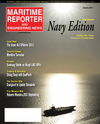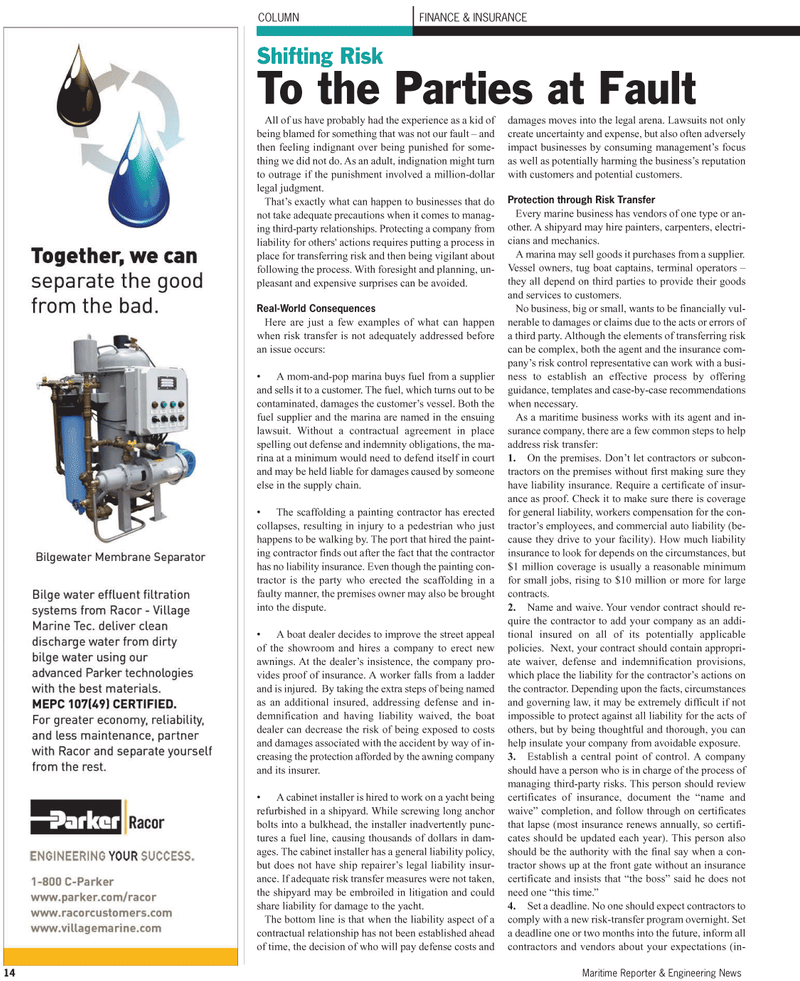
Page 14: of Maritime Reporter Magazine (January 2011)
International Naval Technology
Read this page in Pdf, Flash or Html5 edition of January 2011 Maritime Reporter Magazine
14 Maritime Reporter & Engineering News
All of us have probably had the experience as a kid of being blamed for something that was not our fault – and then feeling indignant over being punished for some- thing we did not do. As an adult, indignation might turn to outrage if the punishment involved a million-dollar legal judgment.
That’s exactly what can happen to businesses that do not take adequate precautions when it comes to manag- ing third-party relationships. Protecting a company from liability for others' actions requires putting a process in place for transferring risk and then being vigilant about following the process. With foresight and planning, un- pleasant and expensive surprises can be avoided.
Real-World Consequences
Here are just a few examples of what can happen when risk transfer is not adequately addressed before an issue occurs: • A mom-and-pop marina buys fuel from a supplier and sells it to a customer. The fuel, which turns out to be contaminated, damages the customer’s vessel. Both the fuel supplier and the marina are named in the ensuing lawsuit. Without a contractual agreement in place spelling out defense and indemnity obligations, the ma- rina at a minimum would need to defend itself in court and may be held liable for damages caused by someone else in the supply chain. • The scaffolding a painting contractor has erected collapses, resulting in injury to a pedestrian who just happens to be walking by. The port that hired the paint- ing contractor finds out after the fact that the contractor has no liability insurance. Even though the painting con- tractor is the party who erected the scaffolding in a faulty manner, the premises owner may also be brought into the dispute. • A boat dealer decides to improve the street appeal of the showroom and hires a company to erect new awnings. At the dealer’s insistence, the company pro- vides proof of insurance. A worker falls from a ladder and is injured. By taking the extra steps of being named as an additional insured, addressing defense and in- demnification and having liability waived, the boat dealer can decrease the risk of being exposed to costs and damages associated with the accident by way of in- creasing the protection afforded by the awning company and its insurer. • A cabinet installer is hired to work on a yacht being refurbished in a shipyard. While screwing long anchor bolts into a bulkhead, the installer inadvertently punc- tures a fuel line, causing thousands of dollars in dam- ages. The cabinet installer has a general liability policy, but does not have ship repairer’s legal liability insur- ance. If adequate risk transfer measures were not taken, the shipyard may be embroiled in litigation and could share liability for damage to the yacht.
The bottom line is that when the liability aspect of a contractual relationship has not been established ahead of time, the decision of who will pay defense costs and damages moves into the legal arena. Lawsuits not only create uncertainty and expense, but also often adversely impact businesses by consuming management’s focus as well as potentially harming the business’s reputation with customers and potential customers.
Protection through Risk Transfer
Every marine business has vendors of one type or an- other. A shipyard may hire painters, carpenters, electri- cians and mechanics.
A marina may sell goods it purchases from a supplier.
Vessel owners, tug boat captains, terminal operators – they all depend on third parties to provide their goods and services to customers.
No business, big or small, wants to be financially vul- nerable to damages or claims due to the acts or errors of a third party. Although the elements of transferring risk can be complex, both the agent and the insurance com- pany’s risk control representative can work with a busi- ness to establish an effective process by offering guidance, templates and case-by-case recommendations when necessary.
As a maritime business works with its agent and in- surance company, there are a few common steps to help address risk transfer: 1. On the premises. Don’t let contractors or subcon- tractors on the premises without first making sure they have liability insurance. Require a certificate of insur- ance as proof. Check it to make sure there is coverage for general liability, workers compensation for the con- tractor’s employees, and commercial auto liability (be- cause they drive to your facility). How much liability insurance to look for depends on the circumstances, but $1 million coverage is usually a reasonable minimum for small jobs, rising to $10 million or more for large contracts. 2. Name and waive. Your vendor contract should re- quire the contractor to add your company as an addi- tional insured on all of its potentially applicable policies. Next, your contract should contain appropri- ate waiver, defense and indemnification provisions, which place the liability for the contractor’s actions on the contractor. Depending upon the facts, circumstances and governing law, it may be extremely difficult if not impossible to protect against all liability for the acts of others, but by being thoughtful and thorough, you can help insulate your company from avoidable exposure. 3. Establish a central point of control. A company should have a person who is in charge of the process of managing third-party risks. This person should review certificates of insurance, document the “name and waive” completion, and follow through on certificates that lapse (most insurance renews annually, so certifi- cates should be updated each year). This person also should be the authority with the final say when a con- tractor shows up at the front gate without an insurance certificate and insists that “the boss” said he does not need one “this time.” 4. Set a deadline. No one should expect contractors to comply with a new risk-transfer program overnight. Set a deadline one or two months into the future, inform all contractors and vendors about your expectations (in-
COLUMN
Shifting Risk
To the Parties at Fault
FINANCE & INSURANCE

 13
13

 15
15
